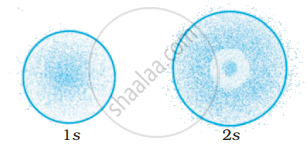Advertisements
Advertisements
Question
Write condensed orbital notation of electronic configuration of the following element:
Chlorine (Z = 17)
Solution
| Element | Condensed orbital notation |
| Chlorine (Z = 17) | [Ne] 3s2 3p5 |
APPEARS IN
RELATED QUESTIONS
Using s, p, d notations, describe the orbital with the following quantum numbers n = 3; l =1.
Using s, p, d notations, describe the orbital with the following quantum numbers n = 4; l =3.
Choose the correct option.
p-orbitals are _________ in shape.
Explain the anomalous behaviour of chromium.
Write orbital notations for the electron in orbitals with the following quantum numbers.
n = 4, l = 2
Write condensed orbital notation of electronic configuration of the following element:
Lithium (Z = 3)
Write condensed orbital notation of electronic configuration of the following element:
Calcium (Z = 20)
Draw shapes of 2s orbitals.
The electronic configuration of oxygen is written as 1s2 2s2 \[\ce{2p^2_{{x}}}\] \[\ce{2p^1_{{y}}}\] \[\ce{2p^1_{{z}}}\] and not as 1s2 2s2 \[\ce{2p^2_{{x}}}\], \[\ce{2p^2_{{y}}}\] \[\ce{2p^0_{{z}}}\], Explain.
The designation of a subshell with n = 6 and l = 2 is ____________.
How many electrons in 19K have n = 3, l = 1?
The three electrons have the following set of quantum numbers:
X = 6, 1, −1, `+1/2`
Y = 6, 0, 0, `+1/2`
Z = 5, 1, 0, `+1/2`
Identify the CORRECT statement.
Which one of the following is NOT possible?
The probability density plots of 1s and 2s orbitals are given in Figure:

The density of dots in a region represents the probability density of finding electrons in the region.
On the basis of above diagram which of the following statements is incorrect?
The number of radial nodes for 3p orbital is ______.
Orbital angular momentum depends on ______.
The pair of ions having same electronic configuration is ______.
Out of the following pairs of electrons, identify the pairs of electrons present in degenerate orbitals:
| (i) | (a) `n = 3, l = 2, m_l = -2, m_s = - 1/2` |
| (b) `n = 3, l = 2, m_l = -1, m_s = - 1/2` | |
| (ii) | (a) `n = 3, l = 1, m_l = 1, m_s = + 1/2` |
| (b) `n = 3, l = 2, m_l = 1, m_s = + 1/2` | |
| (iii) | (a) `n = 4, l = 1, m_l = 1, m_s = + 1/2` |
| (b) `n = 3, l = 2, m_l = 1, m_s = + 1/2` | |
| (iv) | (a) `n = 3, l = 2, m_l = +2, m_s = - 1/2` |
| (b) `n = 3, l = 2, m_l = +2, m_s = + 1/2` |
Which of the following sets of quantum numbers are correct?
| `n` | `l` | `m_l` | |
| (i) | 1 | 1 | +2 |
| (ii) | 2 | 1 | +1 |
| (iii) | 3 | 2 | –2 |
| (iv) | 3 | 4 | –2 |
The arrangement of orbitals on the basis of energy is based upon their (n + l) value. Lower the value of (n + l), lower is the energy. For orbitals having same values of (n + l), the orbital with lower value of n will have lower energy.
Based upon the above information, arrange the following orbitals in the increasing order of energy.
1s, 2s, 3s, 2p
The arrangement of orbitals on the basis of energy is based upon their (n + l) value. Lower the value of (n + l), lower is the energy. For orbitals having same values of (n + l), the orbital with lower value of n will have lower energy.
Based upon the above information, arrange the following orbitals in the increasing order of energy.
4s, 3s, 3p, 4d
The arrangement of orbitals on the basis of energy is based upon their (n + l) value. Lower the value of (n + l), lower is the energy. For orbitals having same values of (n + l), the orbital with lower value of n will have lower energy.
Based upon the above information, solve the questions given below:
Which of the following orbitals has the lowest energy?
4d, 4f, 5s, 5p
The arrangement of orbitals on the basis of energy is based upon their (n + l) value. Lower the value of (n + l), lower is the energy. For orbitals having same values of (n + l), the orbital with lower value of n will have lower energy.
Based upon the above information, solve the questions given below:
Which of the following orbitals has the lowest energy?
5p, 5d, 5f, 6s, 6p
Choose the INCORRECT statement
In assigning R - S configuration, which among the following groups has highest priority?
